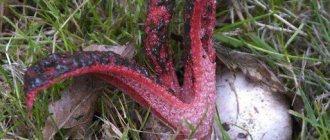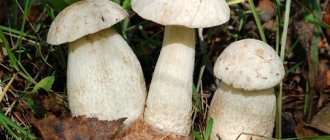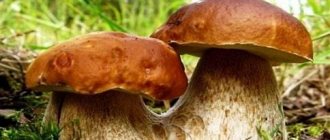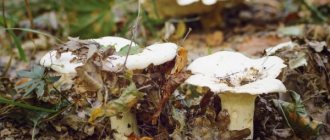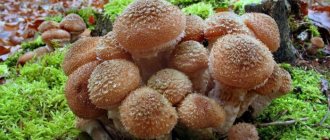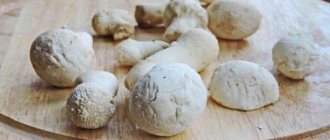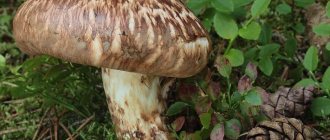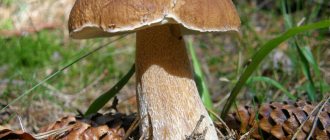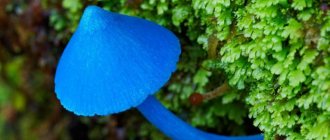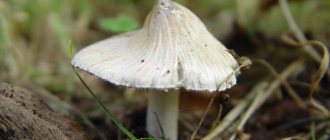An interesting representative of the mushroom kingdom is the Bloody Tooth mushroom, which received its name due to its unconventional appearance. They first wrote about it in 1913, although it was found much earlier (1812). But even now it remains a mystery to scientists, since it has not yet been fully explored.
The Latin name for the Hydnellum peck mushroom is Hydnellum peckii (it was named after the American scientist Charles Horton Peck, who studied it).
Synonyms: there are many other names, some associate it with berries in sour cream - “strawberries and cream”, a mushroom on which raspberry syrup has been poured, “tooth with red juice”, and to some it resembles chewing gum with berry filling , “devil's tears”, devil's hedgehog, bleeding hedgehog, devil's tooth, tooth mushroom, tooth juice (the red-juice tooth), devil's tooth. Most often called a bleeding tooth (bleeding tooth fungus).
Appearance (description)
With its appearance, the Bleeding Tooth mushroom can greatly frighten you or, conversely, interest you, depending on what it is associated with. With their appearance, individuals not only attract people, but also attract insects, which make a wonderful “dinner”. The fruit body is whitish, velvety, but over time it becomes brownish.
Bloody tooth mushroom: interesting facts
Since they lack the function of absorbing carbon dioxide, they feed on useful substances from the soil and insects that land on their caps, immediately stick and die.
Fruiting body. Its white (slightly pink) velvet cap has a bizarre shape with small depressions on which there are droplets of bright red color passing through the pores. Most people associate them with blood. With age, growths appear along the edges (much like teeth). This is where the name Bleeding Tooth comes from.
The cap is whitish-pinkish and irregular in shape, usually with a diameter of 5-7 cm (with the exception of 10 cm). As they age, the cap changes from an attractive whitish and fleshy one to a red-black and then brown plug.
The leg of this representative is very small - 2 cm (in the shape of a cone) of a whitish color (matching the color of the cap), it is almost invisible and, if you look closely, you can see how skillfully it “hid” in the moss or in the ground.
Brown spore powder is found on numerous needles on the bottom of the mushroom.
The flesh is white, but darkens with age. It's always a little darker closer to the stem.
Smell and taste. The smell is almost imperceptible, although it may seem like it smells like strawberries. The taste is bitter. There is no need to try the mushroom, as it is poisonous. Anyone who wants to test what the Hydnellum peca mushroom tastes like or its red liquid similar to raspberry or strawberry jam will die.
Useful Application
Bloody Tooth Mushroom - forest pie with blood
Gindelum Peka is considered inedible due to the bitter taste of its pulp, but there is no data yet on the presence of any toxins in it. Some people suspect the red liquid secreted by the mushroom cap is toxic, but there is no official scientific data yet. The liquid is used as a bait for insects, attracted by its smell, landing on the cap and getting stuck in it. There is evidence that the fungus absorbs stuck insects, using them for nutrition, but the specific action of the absorption mechanism has not yet been described.
There are different opinions regarding the degree of bitterness of the mushroom pulp; some are more inclined to consider its taste more pungent than bitter. According to available data, the bitterness is completely preserved in dried fruit bodies.
In any case, there is no evidence of consumption of this mushroom as food.
In Europe, dyes of various shades were made from the fruiting bodies of Hindelum Peck - from beige to green and blue.
This mushroom contains atromenthin, which has anticoagulant and antibacterial properties, and the squeeze from the fruiting bodies of Hindelum Peck can be used to prevent blood clots and fight bacterial pneumonia. Scientists are conducting research on the use of substances contained in this mushroom as an analogue of penicillin and a means to combat Alzheimer's disease.
Where does the Bloody Tooth mushroom grow?
This mushroom can only be seen in coniferous forests. The countries with the most favorable conditions for its growth are in North America, Australia and central Europe. It is also found in the Pacific Northwest, Korea and Iran. In the CIS countries, it is extremely rare to find Bleeding Tooth, although the climate is constantly changing and therefore new species of mushrooms appear where they have never existed before, and some, on the contrary, disappear.
Hydnellum peka prefers sandy soils because they absorb moisture better. He loves “loneliness”, because of this he is found in most cases as a single specimen, although a small group can also be found.
Edible or not?
“Hydnellum Peca” belongs to the order of Agaricales mushrooms, however, unlike the same champignons, it is not edible. The fruit body does not contain poison; the danger comes only from the pigment located in the cap (atromentin). Its toxicity is still being studied and it is not yet known whether it is fatal to humans. The mushroom has a bitter taste - it needs this to scare away people and animals.
Medicinal properties
It was once used on the farm to create a dye. It also has beneficial properties, namely antibacterial. It contains the pigment atromenthin, which is very valuable in medicine, as it can cure many people suffering from blood clots. With its help, you can easily avoid the formation of blood clots. But, unfortunately, this mushroom is not yet used in medicine, although they believe that very soon they will receive miracle drugs, just as they previously obtained the antibiotic penicillin from the fungus Penicillium notatum.
Carefully
Bloody Tooth Mushroom – forest pie with blood
Research shows that Gindelum Peka has an increased tendency to accumulate radioactive cesium - 137. Accordingly, the higher the level of radiation pollution in the mushroom’s habitat, the greater the amount of this dangerous radioactive nuclide will settle in the pulp of the mushroom. Considering the non-use of the mushroom for food, this information is not so important, but it also needs to be taken into account.
At the same time, Gindelum Peck itself is very sensitive to the degree of environmental pollution, especially nitrogen deposits in soils, and in some areas of Europe there has been a decrease in the population of this fungus caused by an increase in the degree of environmental pollution.
Bloody tooth mushroom: photo
Close relatives"
Bloody tooth is not the only representative of the Gidnellum family. The closest and equally inedible three representatives are:
- Hydnellum ferrugineum. Its distinctive features appear at the maturity stage, when the fruit body loses its light shade and acquires a thick rusty color, characteristic of this species. The pigment color distinguishes the rust mushroom from an ordinary bloody tooth.
- Hydnellum caeruleum. This species is found mainly in northern European forests, where white mosses grow, next to which blue mushrooms appear. The flesh is an expressive blue color; it also secretes liquid in drops of bright scarlet color along the cap surface.
- Hydnellum suaveolens. A representative of the same species, but does not secrete red juice throughout the entire growth cycle. It has a characteristic pungent odor, which distinguishes it from other mushrooms of its genus.
Thanks to the unforgettable appearance that the bright scarlet liquid provided the mushroom, it is difficult to confuse it with other species. It stands out from others and is clearly visible from afar. But, if you do not take into account the color of the juice, then in appearance the bloody tooth vaguely resembles milk mushrooms.
In ancient times, even before the introduction of artificial dyes, blood mushroom juice was used for coloring, which did its job well. It is believed that if you infuse this liquid with alcohol, you will get a good tincture that promotes the rapid healing of bruises and abrasions on the body. But testing such recipes on yourself is unsafe.
The mushroom was known long before anyone, in the name of science, decided to taste it. It is only known that the researcher died suddenly from poisoning, and the victim was never properly appreciated, since no one knows his name.
Interesting! Previously, the bloody tooth did not grow on Russian territory, but in 2012 it was discovered on the territory of Buryatia by local summer residents who went out into the forest. Such a find puzzled mushroom pickers, but they explained this phenomenon quite simply. Due to the fact that the world's climate is gradually changing, places suitable for the growth of this species have appeared in Russian forests. Later, the mushroom was found in other parts of the country, which confirmed the theory that was put forward earlier.
Habitat
The fruiting bodies of Hydnellum peckii have been found to grow alone, scattered or grouped together on the ground under coniferous trees, often among mosses and pine needles.
The fungus is widespread in North America, especially in the Pacific Northwest. Its range extends north to Alaska and east to North Carolina. In the Puget Sound region of Washington State, USA, it is found in association with Douglas fir, silver fir and hemlock. Along the Oregon coast it has been found under a pine tree. In addition to North America, the fungus is widespread in Europe, with its presence documented in Italy, Germany, and Scotland. It is also found in other European countries, but much less frequently. Increasing pollution in central Europe has been suggested as one possible factor in the decline in fungal populations. Reports of the mushrooms being found from Iran in 2008 and Korea in 2010 were the first outside Europe and North America.
Habitat and distribution
Fruit bodies of Hydnellum peckii
found, becoming solitary, scattered or grouped together on the ground under coniferous trees, often among mosses and pine needle debris.
H. peckii
is a “late stage” fungus that, in arctic forests dominated by Banks pine, typically begins to associate with more mature hosts once the canopy has closed. A preference for mountainous or subalpine ecosystems has been noted.
The fungus has a wide distribution in North America and is especially common in the Pacific Northwest; its range extends north into Alaska and east into North Carolina. In the Puget Sound region of the US state of Washington, it is found in association with pseudohemlock, spruce and hemlock. Along the Oregon coast it was collected under lodgepole pine. In addition to North America, the fungus is widespread in Europe, and its presence has been reported in Italy, Germany and Scotland. The species is common in the latter location, but is becoming increasingly rare in several European countries, such as Norway, the Netherlands and the Czech Republic. Increased pollution in Central Europe has been suggested as one possible factor in the decline of the fungus there. Reports from Iran in 2008 and Korea in 2010 were the first outside Europe and North America.
